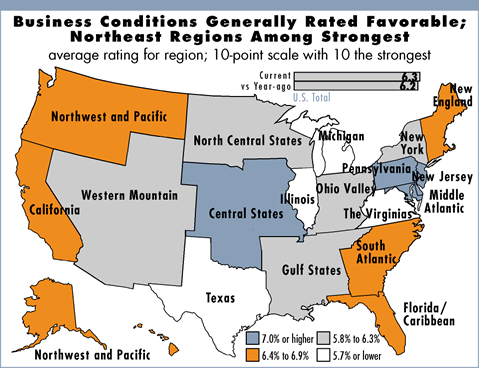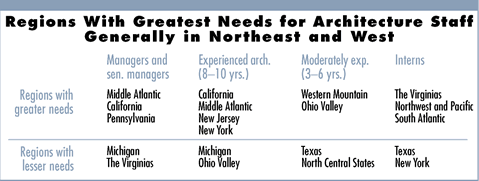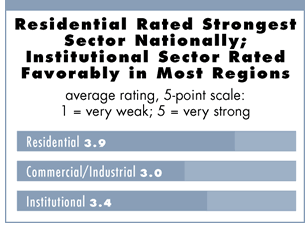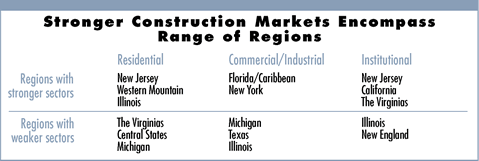

AIA Component Leaders
Rate Business Conditions as Fair to Good in Their Areas
Moderately experienced architecture staff in greatest demand; residential
remains strongest sector

by Kermit Baker,
PhD, Hon. AIA
Chief Economist
This year is shaping up as a good one from a business perspective for most architecture firms. And, given the recent trends in business activity, next year looks to be even better. AIA component leaders recently reported on business conditions in their areas, and most provided positive assessments.
When asked to rate business conditions at firms in their area on a 10-point scale—with 1 indicating “terrible” conditions, 5 indicating that they are “so-so”, and 10 as “couldn’t be better”—component leaders reported average business conditions as 6.3. Leaders from 11 of the 18 AIA regions rated conditions on average in their area as 6.0 or better. Conditions in only one region averaged below a rating of 5.0.
Component leaders in the Northeast are the most upbeat about conditions. Ratings in each of the AIA regions in the Northeast provided average ratings at or above the national average. Leaders in the West also provided a positive assessment. Of the AIA regions in the West, only the Western Mountain region was rated below the national average for current business conditions.

![]()
![]()
Business conditions are not only rated as solid in most regions, but also as having improved from a year ago. No regions were reported as having business conditions worse than a year ago, and only a few reported no improvement or only modest improvement. Leaders in the Pennsylvania region expected the greatest improvement from a year ago, but other regions where leaders felt that business conditions had improved over the past year were spread across the entire country.
Moderately experienced staff in most demand
As business conditions improve in most regions, firms are beginning to
increase their staffing. However, component leaders report greater
need for some positions than others. Managers and senior managers generally
are in least need. On a 3-point scale—with 1 indicating “no
need” and 3 indicating “great need”—managers
and senior managers averaged a score of 1.6 nationally. In no region
were these positions reported to be in “great need”; at
best, they were reported to be in “some need” in a few
regions.
Experienced architects (defined as those with 8-10 years of experience) were generally reported to be in greater need in most regions than were managers. Expressed need for these positions averaged 2.1 nationally on a 3-point scale, with almost all regions reporting at least some need. A few regions reported scores indicating a great need for these positions.
Moderately experienced architects (defined as those with 3-6 years of experience) also are in need at firms. Expressed need for these staff averaged 2.2 nationally on a 3-point scale, the highest score of all positions covered in this survey. Component leaders in all regions reported at least some need for staff at this experience level.
Need for intern staff averaged 1.9 nationally, just below scores for experienced and moderately experienced architects. Component leaders reported at least moderate need for these positions in most regions, although no region was reported as having a great need.

Residential remains healthiest construction sector
While the commercial/industrial and institutional construction sectors
have ebbed and flowed in terms of their strength in recent years, residential
activity has remained consistently solid. Nationally, component leaders
rated residential activity on average at 3.9 on a 5-point scale, just
below a score of 4 indicating “strong” conditions. Residential
activity was rated as the strongest—or tied as the strongest—building
sector in 17 of the 18 AIA regions, the lone dissenter being The Virginias,
which put institutional buildings at the top of the list.
 Institutional buildings averaged a 3.4 rating nationally,
just about halfway between “moderate” and “strong.” This
sector was rated as at least moderate by leaders in all regions, and
strong in several. Most component leaders rated the institutional sector
below the residential sector in terms of current health. Likewise, most
ranked this sector ahead of commercial/industrial activity.
Institutional buildings averaged a 3.4 rating nationally,
just about halfway between “moderate” and “strong.” This
sector was rated as at least moderate by leaders in all regions, and
strong in several. Most component leaders rated the institutional sector
below the residential sector in terms of current health. Likewise, most
ranked this sector ahead of commercial/industrial activity.
Commercial/industrial buildings are still showing signs of weakness in several regions, averaging on 3.0 (moderate strength) nationally. This sector was rated as weak in two regions and strong in two, with the rest scoring this sector as exhibiting moderate strength. Coastal areas tended to have higher ratings for this sector, while interior areas (Midwest, central and south central U.S., and Southwest) generally reported weaker conditions.

Copyright 2004 The American Institute of Architects.
All rights reserved. Home Page ![]()
![]()
 |
||
| How the survey
was conducted The AIA national component has conducted a survey of business conditions in the AIA regions annually for the past seven years. This survey builds on a similar effort previously conducted among AIA components by the Boston Society of Architects for a number of years. This year’s survey was conducted September 14–24. Questionnaires were e-mailed to 609 component executives, presidents, and presidents-elect. One hundred forty-nine responses were returned, with multiple responses for each of the AIA regions. Regionally, figures were computed as the average of all responses submitted by respondents from that region. This year, components are saying: • Firms are having a difficult time finding experienced
architects (8–10 years) to hire in our area. • The Bay Area seems better than the last two years, but
with little cause for significant optimism. • Residential market remains very strong. School work is
being held hostage to state/local government claims of budget problems. • Everyone is busy in this area. We are having difficulty
finding experienced interns and beginning architects.
|
||